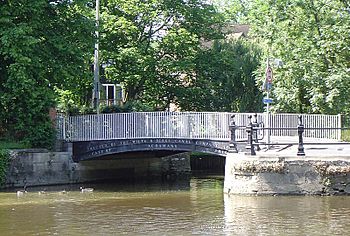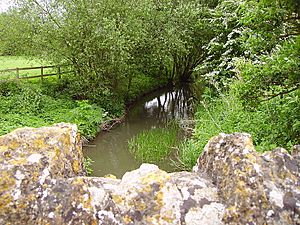River Ock facts for kids
Quick facts for kids Ock |
|
|---|---|

Bridge across the River Ock as it flows into the Thames at Abingdon
|
|
| Country | England |
| Counties | Oxfordshire |
| Towns | Abingdon-on-Thames |
| Physical characteristics | |
| Main source | Little Coxwell, White Horse Hills |
| River mouth | River Thames Abingdon-on-Thames, Oxfordshire |
The River Ock is a small river in England. It flows through Oxfordshire and is a tributary of the famous River Thames. This means the Ock flows into the Thames, adding its water to the larger river.
The area where the River Ock collects its water is called its catchment area. For the Ock, this is the Vale of White Horse. This is a wide, flat valley in the southern part of Oxfordshire. The Ock finally joins the River Thames at the town of Abingdon-on-Thames.
Contents
Where Does the Ock Flow?
The River Ock begins its journey near the village of Little Coxwell. As it flows, it gathers water from smaller streams. These streams come from villages located at the bottom of the Berkshire Downs, also known as the White Horse Hills.
Springs from these chalk hills helped early settlements grow there. One of the streams that joins the Ock is the Osse Stream, which starts in Cumnor.
The Ock's Path to the Thames
From Little Coxwell, the Ock flows past several places. It goes around Longcot and then past Stanford in the Vale. At Stanford, the river is about 3 meters (10 feet) wide. The name Stanford might come from "stony ford," which could mean a rocky place where people used to cross the Ock.
The river then continues past Charney Bassett, Lyford, Garford, and Marcham Mill. Finally, it reaches Abingdon-on-Thames. Here, the Ock flows into the River Thames. An old iron bridge crosses the river at this meeting point. This bridge was built by the Wilts & Berks Canal Company.
What's Under the River?
The River Ock flows over different types of rock. These rocks were formed millions of years ago during the Jurassic period. They include Greensands, Gault, Kimmeridge Clay, and corallian limestone. Some of the smaller streams that feed the Ock start from springs in chalk hills.
River Life and Flooding
In the past, the River Ock was home to many creatures. These included native crayfish and various types of freshwater fish. However, more houses have been built in the Vale of White Horse. This has led to more surface water draining into the river. Scientists are not sure how this has affected the river's wildlife.
Usually, the Ock is a calm river. But after a lot of heavy rain, it can flood. This mostly affects low-lying areas in south Abingdon. For example, there was a flood in July 2007.
What Does "Ock" Mean?
The name Ock for the river likely comes from an old Celtic word. This word meant 'salmon'. This suggests that salmon might have once been common in the River Ock.


